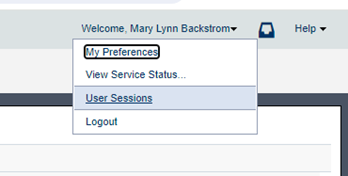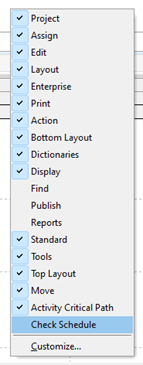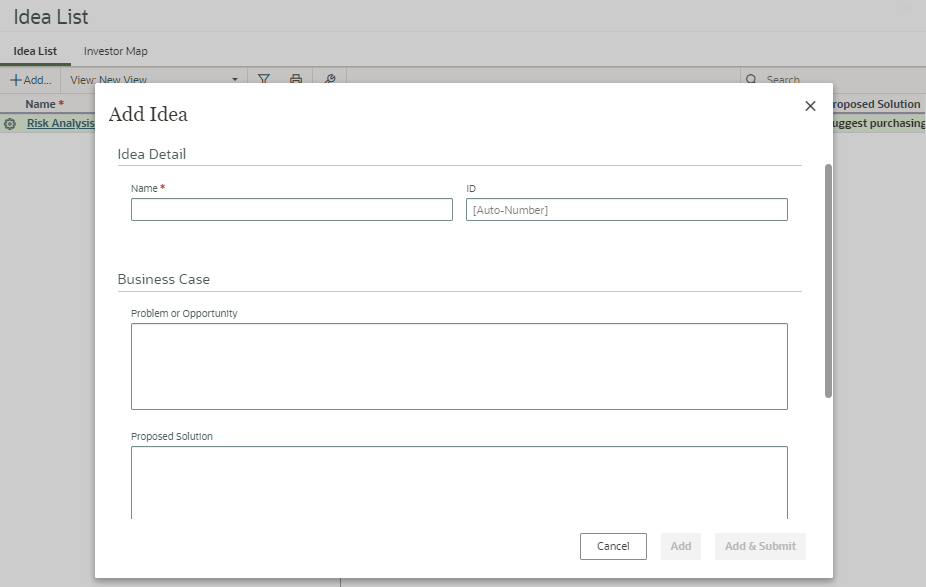Have you seen these new features? They were added in Primavera EPPM version 23.10.
Additions to Viewing Current & Recent User Sessions
By selecting the User Sessions page from the User Menu, users can view information about their recent sessions.

Written by Mary Lynn Backstrom, PMP, PMI-SP, PMI-BA – Implementation Specialist
on Friday, 16 February 2024.
Posted in All Articles, Primavera P6
Easier Hierarchies and Fragnet Templating
Written by Ravi Wallau

Easier Hierarchies and Fragnet Templating
New Features
-
Easier to work with hierarchical fields - WBS, Resources, Roles, Codes, EPS, OBS, and Cost Accounts.
-
Full path extracting and loading for all hierarchical codes makes working with these hierarchies easier in Excel. Several new fields were added including the full code path field and a field showing the level of the hierarchy. This makes building hierarchies in Excel easier and loading them into P6 less error prone. Separator definitions are now also configurable.
-
Allows importing of WBS with their codes (without needing the path) if they are unique across a project
-
WBS template fragnet loader - You can take advantage of WBS templates built in P6 within P6-Loader to copy WBS nodes, activities, resources assignments, logic, steps, and expenses from one or many templates and fill in any placeholders for activity ID and names as you generate new WBSs into your project. You can also assign UDFs and codes to WBS, activities and resource assignments while applying a template. This is like the old P3 Fragnets on steroids.
-
Improving the handling of spread information to allow quarterly and yearly spread extractions are back. Manual spread loading of these spread periods is not supported.
-
Automatically starts activities when loading resource assignment period actuals.
Enhancements
-
Better error handling with the API when loading batches and better controlling of batching.
-
Includes project names and activity names in the relationship sheet when extracting.
-
Fixes a problem that would occur when trying to extract project data with no projects selected.
-
Better use of UI space in the bottom toolbar.
on Friday, 09 February 2024.
Posted in News, P6-Loader
Let’s take a quick look at the Check Schedule Toolbar functionality in P6 v23.12.1. (This toolbar was put into P6 in v22.4.)

Enabling the Check Schedule toolbar displays the toolbar icons below.

Working across the Check Schedule toolbar, the functions behind the icons are shown.
Written by Mary Lynn Backstrom, PMP, PMI-SP, PMI-BA – Implementation Specialist
on Friday, 02 February 2024.
Posted in All Articles, Primavera P6
Your P6-QA metrics are now available in Power BI reports. You can also create custom reports via our P6-Reporter tool in your corporate dashboards. These reports include time based metrics to help you see where in your project these quality issues exist.
Written by James Andrade

Your P6-QA metrics are now available in Power BI reports. You can also create custom reports via our P6-Reporter tool in your corporate dashboards. These reports include time based metrics to help you see where in your project these quality issues exist.
New Features
-
New UDFs to show variances and calculated values - P6-QA may report that you have activities that are overdue for updating, but are they over by 2 days or 2 months? And what is your project's critical path length index (CPLI) exactly? Now you can view these metrics right in P6 to know how close they are to your target values.
-
Indicators for resource assignments - P6-QA has reported you have resource assignments that are missing roles, actuals or perhaps are over budget. In this release, we've added indicator UDFs. P6-QA populates them to let you find the affected resource assignment with ease.
-
P6-Reporter Ready - We've added custom tables to our P6-Reporter tool that neatly arrange your P6-QA data, including all of the inspection details, so it's ready to be put into the reporting software of your choice.
-
P6-QA statistics can now be pushed into time-based graphics. Being able to critique different portions of your schedule to get a much better idea of the risks and timing of those risks.
on Tuesday, 30 January 2024.
Posted in News, P6-QA
Primavera P6 utilizes CPM or Critical Path Method Scheduling. Using the activity information in a P6 schedule file, the early and late dates are calculated when the project is scheduled. P6 uses the activity durations and the relationships between the activities to calculate schedule dates. The schedule calculations are completed in two passes: the forward pass in the scheduling process calculates the early dates of each of the activities and the backward pass calculates the late dates. If the activity information (durations or logic) in your P6 schedule is incomplete or incorrect, scheduling results will be affected.
Written by Mary Lynn Backstrom, PMP, PMI-SP, PMI-BA – Implementation Specialist
on Friday, 05 January 2024.
Posted in All Articles, Primavera P6
Recently, a client of ours was using P6 Pro Client with P6 Pro Cloud Connect and had the caching option enabled. This user was using an older version of P6, 18.8, and in this version, problems with P6 Pro Cloud Connect were much more common than in the current version. The user would log into P6, logging in would take a few seconds, and then P6 would just crash. We checked the user configuration and disabled caching, and the user was able to login into P6 after that.
However, the user soon noticed that some of the projects he was working on were gone. What happened?
Written by Ravi Wallau - Integration Specialist
on Wednesday, 13 December 2023.
Posted in All Articles, P6-Loader
The Ideas functionality in Oracle Primavera Cloud (OPC) allows for the submission of ideas which are then tracked, processed and evaluated. This assists with selection from the submissions, ideas to accept and potentially implement as projects. Each idea is registered, submitted, and then the idea is displayed in the Idea List.

Written by Mary Lynn Backstrom, PMP, PMI-SP, PMI-BA – Implementation Specialist
on Wednesday, 06 December 2023.
Posted in All Articles, Oracle Primavera Cloud (Prime)
Easily Manage Key Resources and Mandatory Activities in P6!
Written by Ravi Wallau

Easily Manage Key Resources and Mandatory Activities in P6!
New Features
-
Custom field copy - copy custom fields from the primary resource into the activity that holds it, or assign a value in a UDF or code based on the calendar the activity has selected. The rules are fully customizable, and it is possible to create match rules using regular expressions.
-
Required objects feature - check if your project has required objects based on pre-defined rules in the program, and fix the problem if possible or alert the user if that is not possible. For example, WAIT activities with a pre-defined duration and name format.
-
Global change feature - apply changes to project data based on pre-defined rules. For example, change the relationship type from the WAIT activity into its milestone's successors from SF to FF, once the milestone activities have reached a certain status.
-
Resource rate import - allow resource rates to be imported from an external system and applied as new resource rates to the resources, matching on resource codes. Shifts are taken into consideration if they are being used.
-
Dictionary synchronization - in some organizations you may have a project code and an activity code that must have the same values. With this feature, you can define a source code and the code values are synchronized to the target codes. The dictionaries are kept in sync, and if a value is moved in the source hierarchy, it is also moved in the target hierarchy.
-
As part of dictionary synchronization, it is also possible to copy the resource tree as a resource code dictionary.
-
Code assignment copy based on certain rules - for example, you can assign a code in the activity based on a corresponding code value in the primary resource for that activity.
P6-Calculator News Articles
P6-Calculator Case Studies
on Friday, 01 December 2023.
Posted in News, P6-Calculator
Have you ever been working in Oracle Primavera Cloud (OPC) and thought it would be nice if a specific piece of functionality was available? New functionality has been added to OPC v23.11. The below list highlights a few items you may find particularly interesting.
Written by Mary Lynn Backstrom, PMP, PMI-SP, PMI-BA – Implementation Specialist
on Saturday, 25 November 2023.
Posted in All Articles, Oracle Primavera Cloud (Prime)
Swim lane displays can be created in the Tasks App under Work Plan in the Oracle Primavera Cloud (OPC). Using Swim Lane displays allows the user another option to review and make changes to tasks. Swim Lanes can be grouped by company then user, user then company, or just company or user. Along with providing views of tasks (and activities) by whichever grouping you choose, you can reassign tasks to a different company, user or both using the task details or by dragging and dropping the task to the required group in the work plan.
Written by Mary Lynn Backstrom, PMP, PMI-SP, PMI-BA – Implementation Specialist
on Thursday, 02 November 2023.
Posted in All Articles, Oracle Primavera Cloud (Prime)
Do you monitor the ‘What’s New’ information for new versions of Primavera P6? Here are a few things to keep in mind when working in the P6 Client. For those using P6 v20.4 (or higher), there are a couple of new pieces of functionality (introduced in v20.4 of P6 Professional) that can prove helpful. This functionality allows the addition of comments about relationships as well as the functionality allowing role prices to vary over time.
Regarding the functionality to add comments about relationships, I am not suggesting that every relationship line in your P6 schedule requires comments added; however, in some circumstances it can be a handy functionality. The comments column can be added in the relationship details tab (predecessors/successors or relationships) and then the comments required can be added. Perhaps you have a lag on the relationship, or, like below, you want to confirm a relationship. Relationship comments are plain text and can be up to 250 characters long.
Written by Mary Lynn Backstrom, PMP, PMI-SP, PMI-BA – Implementation Specialist
on Wednesday, 25 October 2023.
Posted in All Articles, Primavera P6
Safran Risk has released v22.2.0. Read about all the exciting new features.
Written by Ian Nicholson

Safran Risk has released v22.2.0. Read about all the exciting new features.
New Features
-
It’s now possible to login to Safran Risk using Azure Active Directory
-
Advanced impact option that lets risks impact activities and costs in new ways. For example, it’s now possible to spread an absolute risk impact over multiple elements. You can also limit the number of mapped elements that will be impacted each iteration.
-
Column picker that lets you select which columns to show.The ability to add a number of new columns that lets you see the distribution values and more as columns.
-
If you’re using Risk Mapping for inputting activity duration uncertainty, it’s now possible to use all distributions here. You can also use absolute and relative.
Enhancements
-
Activity Duration Uncertainty can now be set to any distribution in the Risk Mapping tab
-
Advanced Impacts lets you spread impact over activities or costs and limit the number of impacted elements
-
Schedule data can now be seen as columns in the Risk Mapping tab
-
On a multi-user database the project is now opened in Update Mode (instead of Exclusive) after an import
-
New columns in the Project Risks tab: Schedule Distribution (Pre andPost), Cost distribution (Pre and Post), Post-Mit Probability, Impact Independently, Notes, and Mappings Count
-
Activity Duration has been added to the Risk Mapping Excel import/export. This will allow setting duration uncertainty in Excel.
-
Resource tab added to Risk Mapping so that resources for each activity can be seen
on Wednesday, 18 October 2023.
Posted in News, Safran
Project issues can be very disruptive and expensive. In executing projects, issues can (and most often do) arise at various points. Having a good set of project control procedures and monitoring what processes are in place enables your team to identify issues and act quickly. Meanwhile, creating mitigation plans based on current, correct information is a must. Making decisions based on old data will not set your project and team up for success, and having your team endure long wait times to retrieve, assemble, and analyze current project information when you’re waiting for decisions to be made is not an effective approach either.
If your team’s struggling with time-consuming manual updates, there are tools that can help you automate the process. Emerald’s
P6-Loader allows you to use Excel-based update sheets to load updates into your progress file. Another one of our tools,
TAPS, facilitates updating P6 using activity barcodes (TAPS Classic) or process updates using TAPS Mobile from your phone. These tools make it quick and painless to get accurate updates into your P6 files. Your team will then have more time for analyzing your schedule instead of wasting time with tedious updating.
Written by Mary Lynn Backstrom, PMP, PMI-SP, PMI-BA – Implementation Specialist
on Tuesday, 17 October 2023.
Posted in All Articles, P6-Reporter
Let’s take a high-level look at the timesheet functionality in Oracle Primavera Cloud (OPC). Timesheets provide functionality allowing users to enter hours worked against projects. The project hours are logged against resource assignments on activities. Security privileges assigned to users for timesheets are based on the actions they require access to perform on a timesheet.
OPC contains Timesheet User, Timesheet Supervisor and Timesheet Approvers. Timesheet Users can create timesheets, log time against activities on projects, and submit them for approval. Timesheet Supervisors can create their own timesheets and enter time. They can also create timesheets for the resources assigned to the projects for which they are the timesheet supervisors. They can enter time on behalf of the resources and submit their timesheets for approval. Timesheet Approvers can create their own timesheets and enter time. They can also create timesheets for the resources for which they have been assigned as the timesheet approver. They can enter time, submit, approve, or reject their resources' timesheets.
Written by Mary Lynn Backstrom, PMP, PMI-SP, PMI-BA – Implementation Specialist
on Sunday, 17 September 2023.
Posted in All Articles, Oracle Primavera Cloud (Prime)
Are you new to using Oracle Primavera Cloud (OPC) for your project scheduling? When entering or importing information, keep in mind OPC is structured into modules. When you login, you will have icons available for the modules you have been assigned access to. For a quick walk through of a few items of interest, we will start by looking at the Utilizing the Scope Module which gives access to the windows in the list below.

Written by Mary Lynn Backstrom, PMP, PMI-SP, PMI-BA – Implementation Specialist
on Monday, 11 September 2023.
Posted in All Articles, Oracle Primavera Cloud (Prime)









